So in January, some of the guys down at the store started playing Chain of Command, a platoon-sized WW2 skirmish game. People had sort of settled on Bolt Action as their go-to ruleset for this (and indeed, I painted up a bunch of 28mm Soviets), but Chain of Command really blew me away. There's a real focus on good tactics and the fog of war. There's also a short pre-game "patrol phase" where both sides maneuver to set up "jump-off" points where their forces will enter during the actual game. This eliminates a lot of the tedious early maneuvering most games have and basically sets your forces up within shooting distance of the enemy.
A fun game and the guy championing this stuff has mostly 15mm figures. That's good, 15mm is sort of my preferred scale (since my bad paint jobs aren't as noticeable) so I figured I'd paint up a platoon.
In the past two months I've done 4. So I've painted over 120 figures and can field a platoon for every major combatant of WW2 in Europe. So...I think I'm into this game. At any rate, here's a dump of photos showing off everything:
First up, the Americans:
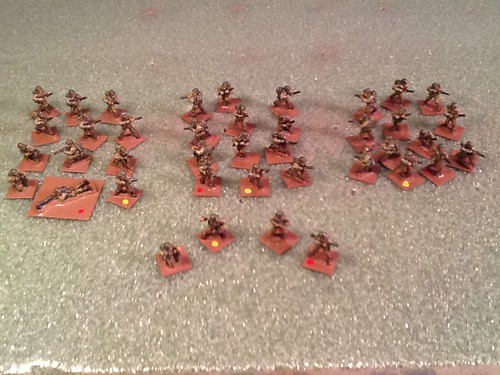
Here's the full platoon in all it's glory. The Americans have lots of guys and a smattering of support. The large squads can soak losses pretty well and remain functional.
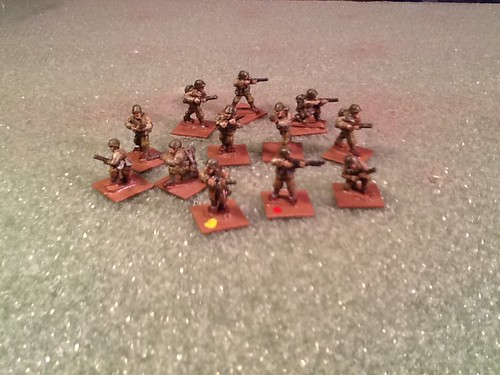
Each squad has a leader, a BAR team and 9 grunts. The BAR was a pretty sub-par squad support weapon, but it was easy to fire on the move.
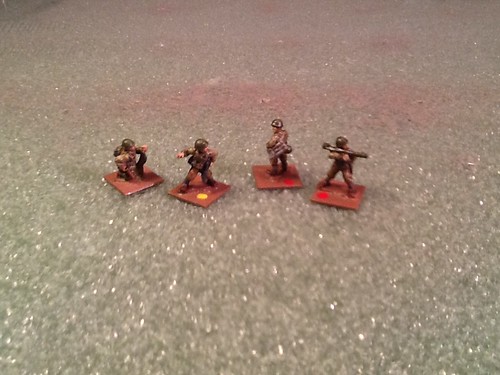
Finally, the Platoon HQ with the Platoon Leader and Platoon Sgt. (the pack I bought didn't have one, but it did have a spare rifleman so he's the new top NCO). The HQ also has the squad's anti-armor support with a two man bazooka team. I thought the bazooka itself was a little small, but some internet research suggests it's about right. Anyway, the HQ provides some much-needed flexibility.
Next up are the Soviets. And now I have the same basic troops in two different scales (15mm and 28mm)...I'm becoming a true wargamer!
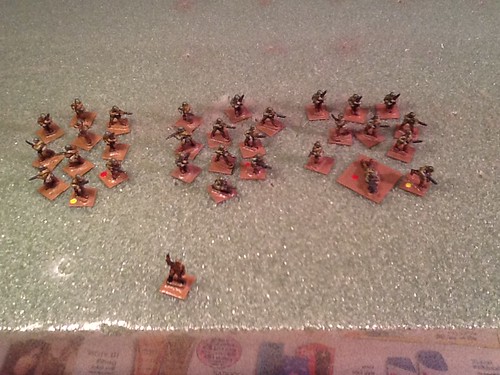
Here's the whole platoon. Actually, the pack of figures I bought comes with a whole bunch of extra guys. I had enough dudes left over to make a fourth squad of guys and a small SMG team. With a couple more support weapons and a tank, I could replicate my 28mm Bolt Action Soviets and run the game in 15mm if I chose.
But for Chain of Command, you get a platoon leader and three big squads. Like the Americans, they take a lot of hits before they break. Their LMG team is a bit better than the BAR the Americans use, but there are no support units of any sort. To make up for that, the Soviets will usually get a nice pick of support options to bulk out their forces before the game starts.
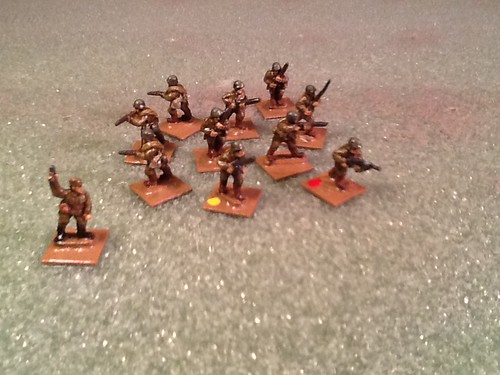
Here's a single Soviet quad and the platoon leader (there's really no one else in the platoon HQ). You get a leader, an LMG team and 8 troopers. The squad has some flexibility to detach scout teams, but mostly it just wants to roll over the opposition. Again, the Soviets hope for a mass of support options to beef up their firepower.
And now for something completely different...
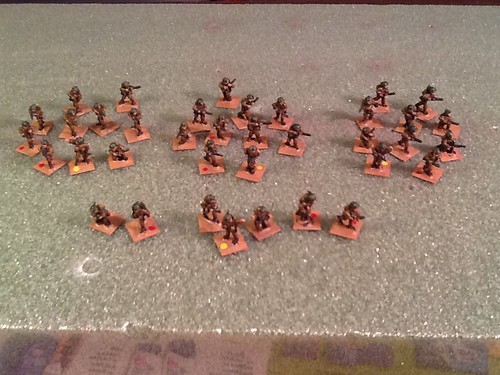
A group shot of the British platoon. The British platoons are a sort of jack-of-all trades. The platoons have a little fire, a little movement, a little artillery and a little anti-tank. The squads can take a few hits, but they won't take a real pounding and have to use everything at their disposal to win. I'm curious to give these guys a go since I think they need a delicate touch to be used well, but once you understand how to use them, they'll be a real menace in the field.
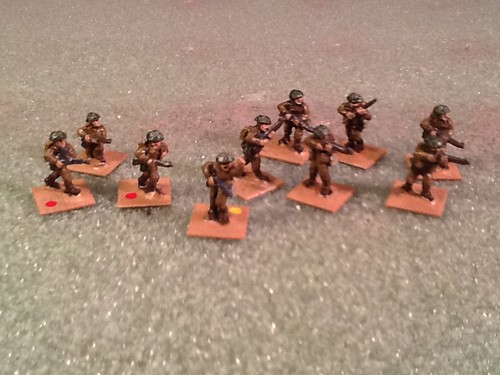
So the rifle squad is very firmly centered on a fire and movement doctrine. The Bren team set up a very accurate base of fire while the rest of the squad moves around to flank and close with the enemy. The only question is where do you place the squad leader? Ideally, he should be with the maneuver unit ready for the final charge, but keeping him back with the Bren to direct fire is a good idea too.
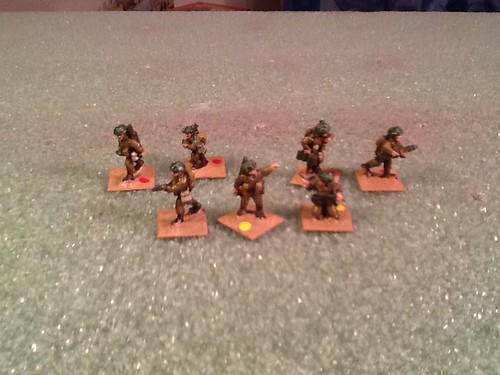
The British Platoon HQ is where the Brits keep the good stuff. The Platoon leader also has a Platoon sergeant who gives the force a lot more command and control options than other forces. There's also a PIAT team who can take their spring-loaded mayhem machines and try for a flank shot on a panzer. The HQ also has a 2" mortar team (only the British platoon have organic artillery pieces). The mortar can fire explosive rounds but is probably better employed in dropping smoke to cover the advance of other members of the platoon. Again, how the British makes use of all his toys will probably determine victory or defeat.
And finally, some Germans for all those other guys to fight.

For the Germans, I put together a Panzergrenadier platoon. This formation has proven to be an interesting opponent. Although the platoon is smaller that the other forces described above, each squad comes with two LMG teams. This means that when a squad fires, it's rolling buckets of d6s and putting a serious hurt on opponents.
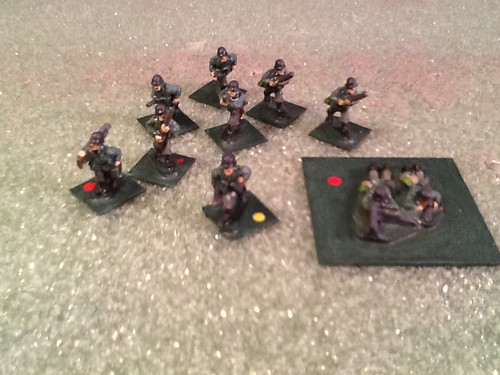
And here you can see the platoon. Two LMG teams but only five troopers. If you can get a few hits on this squad it starts breaking down pretty fast, but getting those hits is a real challenge. On the attack, the squad can make effective use of bounding fire to approach a target. Dug-in on the defense, they're almost impossible to shift. They're always an interesting problem to solve.
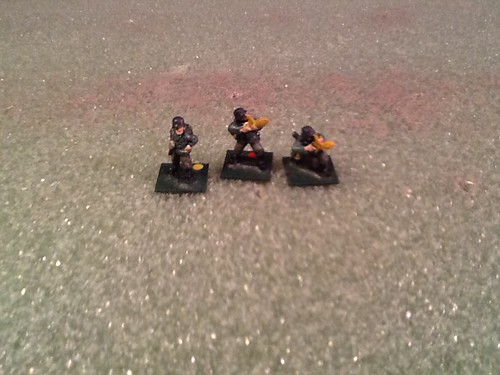
The Platoon HQ for the Panzergrenadiers is a little thin. There's no Platoon Sgt. like the Americans and Brits have so the Germans can run into Command and Control problems. The HQ also contains the platoons anti-armor support in the form of a panzershrek team. Alas, I couldn't find the right figure pack for that, so two panzerfaust-wielding troopers are standing in.
Like I said, that's some 120+ little dudes in two months and now I can field a basic force for pretty much any ETO game. Although my photos continue to be crappy, I'm really happy with how these guys came out. I tried a few new things and I think my painting has really improved in this batch of figures. The improvements basically boil down to two things.
One: I used a bigger brush. Until now, when I paint 15mm the idea was "smaller figures, smaller brushes" and it works ok, but after watching a few videos I did all of these with a larger brush. I say "larger" but it's still pretty small (a size 0 brush instead of a size 3/0 brush -- apparently you can divide by 0 when you're doing art). In the past, I found this larger brush to be too big, but apparently my brush control has improved to the point where I can effectively use the larger brush. This has made things go faster and the brushes have lasted longer than the smaller ones.
Two: I did a lot more highlighting this time around. Normally I block out the basic colors, brush on the shade and that's about it, but this time I really added some serious highlights. This has made the figures really pop. They look a bit funky up close but on the table they look really good.
So I'm happy to see that practice does make perfect.
So that's how I've been spending my free time the past couple of months. I need to paint up some vehicles for each of these groups (and maybe add a few more support troops), but I'm ready to give this a rest for a bit. The next item on my docket is the last of the RAFM Shadows and Steel boxed sets I've been working at on and off the past couple of years -- The Conquistador Dwarves! Should be a fun project.